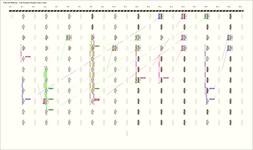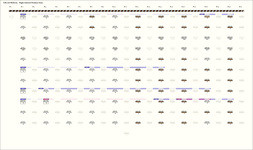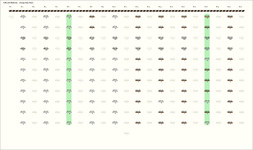| Notes: |
Ascher Databook Notes:
- Construction note: The twisted ends of the main cord and first cord are linked together. Cord 1 is shorter than the other pendants and bound with thread at its end.
2.Construction note: Subsidiaries attached to the first subsidiary on pendants 2, 24, 135, 157, 179, and 201 are attached in a non-standard way. They are looped around both the pendant and subsidiary to which they are connected.
- This is one of several khipus acquired by the Museum in 1907 with provenance Ica. For a list of them, see UR1100.
- Assuming that the first pendant and the last pendant in the 10th group are markers, the khipu is separated, by markers and spacing, into 2 parts of 10 groups each. Each group has 11 pendants.
- With the exception of groups 7 and 17 (the 7 th group in each part), each group has the same patterning of colors: 2X, 2Y, 7X, Y is BB: W in all groups except groups 16 and 17 in which it is LC:W. The X varies so that the group colors alternate. In the first part (with the exception of 2 pendants in group 7), X is W in groups 1, 3, 5, 7, and 9 and it is LB in groups 2, 4, 6, 8, 10, In the second part: X is B in groups 11, 13, 15, 19; LB in 12, 14, 16; and YG in 18 and 20.
- In every even group (groups 2, 4, 6, ..., 18, 20), all pendants are zero-valued (or blank) and there are no subsidiaries.
- In every odd group (groups 1, 3, 5,..., 17, 19):
- Positions 4 and 11 have no subsidiaries; position 3 has 1 W subsidiary; and position 1 has 3-6 subsidiaries or subsidiaries of subsidiaries. The unusual attachment noted in #2 above only occurs in the first position. Other positions vary from 0-3 subsidiaries from group to group.
- Pendant 11 is always zero-valued (or blank).
- The value in position 1 is the maximum.
|



















